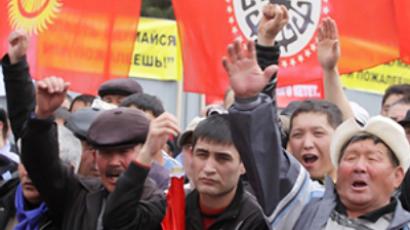Wikileaks strikes again, reveals “failing war effort” in Afghanistan

The whistle-blowing website Wikileaks has released a large cache of secret military documents from the War in Afghanistan that draws back the curtain on the drawn-out operation.
The Guardian, the New York Times and Der Spiegel were granted access to over 90,000 documents that paint a grim picture of a failing military operation against the backdrop of disproportionate civilian deaths, stiff Taliban resistance and possible double-dealings on the part of Pakistan’s Intelligence Service (ISI) and the Taliban.“It is a complete history of the Afghan war from 2004 to 2010,” said former hacker Julian Assange, Wikileaks' founder.Assange added that around 15,000 documents of the “Afghan War Diary” were not turned over to the media because they may have revealed the identity of the informants (this logic seems rather strange since withdrawing pages of the files, while leaving the reading public in the dark, would provide US officials, it seems, with a huge fingerprint as to whom the whistleblower was since they obviously have their own set of documents to compare with).The whistle-blowing website first made headlines for Assange, 39, in April when it posted a 2007 video of a US Apache helicopter attack in Iraq that left 12 civilians dead, including two Reuters journalists. In the background of the video, military personnel could be heard shouting “good shooting.”The following month, the Pentagon arrested a US intelligence analyst named Bradley Manning in Iraq. The 22-year-old was now faces a military trial for passing secret information.So will the latest release of a veritable mountain of secret Pentagon documents undermine America’s military efforts in Afghanistan? That seems rather unlikely, especially since the mission was shooting itself quite accurately in the foot before Mr. Assange arrived on the scene. Yet the release of the files will certainly provide another source of tension between the US and Pakistan, which was accused in the secret docs of moonlighting, so to speak, with America’s sworn enemy.Pakistan, due to its proximity with the Afghan theater of operations, has been something of a “chosen ally” with the United States in the fight against the Taliban. And part of the relationship, which could best be described as extremely awkward, places Pakistan in the position where it must accept the occasional US drone missile attack on its territory against suspected terrorists, notably in Waziristan in the north-west.Just this weekend, two separate drone attacks in South Waziristan killed 28 suspected militants, intelligence officials said.The US doesn't publicly acknowledge the CIA-run drone program, and Pakistan condemns such strikes in public but continues to support Washington in the program. So it is with little surprise that the relationship may have had its share of unfaithful moments.The New York Times reported at the weekend that documents included in the release suggest that Islamabad has been playing something of a "double game," allowing "representatives of its spy service to meet directly with the Taliban in secret strategy sessions to organize networks of militant groups that fight against American soldiers in Afghanistan, and even hatch plots to assassinate Afghan leaders."One of the most alarming revelations as far as Pakistan is concerned, from a document dated August 2008, identifies a high-ranking officer in the ISI as plotting with members of the Taliban to assassinate Afghan President Hamid Karzai. The document provided no information about how or when such an attack would be carried out.Pakistan immediately rejected the claims.These reports "do not reflect the current on-ground realities," Husain Haqqani, Pakistan's ambassador to the United States, said in a statement Sunday. "Pakistan's government under the democratically elected leadership of President [Asif Ali] Zardari and Prime Minister [Yousuf Raza] Gilani is following a clearly laid out strategy of fighting and marginalizing terrorists and our military and intelligence services are effectively executing that policy.”
Civilian deaths
While the media tended to focus inordinate attention on Pakistan’s alleged back-room activities, the death of innocent civilians was also given its share of exposure in the sensational release.One documented military action out of hundreds shows how easy it may be for the military to cover their tracks after an operation goes terribly awry.According to Wikileaks, on August 21, 2008, a field report was filed. In field report 52169 it says that at 21:46 GMT Task Force Bushmaster reports receiving small arms fire from five anti-Afghan forces (insurgents), 13 kilometers south east of Shindand Airfield. This is the village of Azizabad.Close air support (CAS) was requested by allied troops on the ground. The close air support arrived and opened fire on the insurgents. The aircraft used to engage with the insurgents was a Lockheed AC-130H Spectre, which goes by the nickname "The Angel of Death" and is only flown by the US Air Force.After providing a summary account of items retrieved from the scene, including a Kalashnikov (RPK), ammunition and improvised explosive device making materials, the report then says 30 anti-Afghan forces were killed in the fight and one US military personnel wounded.The battle finished at 04:50 GMTThe information provided in this field report, however, contradicts an official United Nations conclusion of the event. Just days after the event, the United Nations Assistance Mission in Afghanistan (UNAMA) concluded that some 90 civilians were killed during the AC-130H engagement. This was not mentioned in the US ground report.UNAMA also found "convincing evidence, based on the testimony of eyewitnesses, and others" that of the 90 civilians killed, more than half were children.Although most of the civilian deaths were attributed to US forces, which make up the bulk of troops the coalition forces, British forces also had their share of innocent blood on their hands.BBC reported on “at least 21 incidents involving UK troops,” including the son of an Afghan general being killed by a “warning shot” on the day of his brother's wedding in November 2007, and two women and two children whose bodies were discovered after troops called in helicopter gunship support when a soldier was wounded in March 2008.Meanwhile, the Obama administration, which has had ample time to prepare for this latest expected broadside, condemned the release of the documents.“We strongly condemn the disclosure of classified information by individuals and organizations, which puts the lives of the US and partner service members at risk and threatens our national security,” the statement read. “Wikileaks made no effort to contact the US government about these documents, which may contain information that endanger the lives of Americans, our partners, and local populations who co-operate with us.”Yet the statement also mentioned the time frame of the documents, which are a reflection of Obama’s predecessor, George W. Bush, who adhered to a “streamlined” fighting strategy, as put forward by Donald Rumsfeld, his then-Secretary of Defense."It is important to note that the time period reflected in the documents is January 2004 to December 2009," and that the grim picture provided by the released documents was the result of the “under-sourcing” strategy of the previous administration.This latest episode in America’s War on Terror underscores the power of technology for cracking even the armor of military secrecy. From the devastating photos of abuses inside of Iraq’s military prisons, to allegations that the US was sponsoring “extraordinary rendition” programs with its European allies, the United States has been forced to deal with a public accounting of its behavior every step of the way.Although innocents will always become the “collateral damage” in every war, Julian Assange should be applauded for having the courage to do what his conscience told him was right, even when the Pentagon was looking to talk with him. Who knows, it may be one small step for eliminating the specter of war forever. Our tiny planet and its millions of living inhabitants can ill-afford another World War, for it will certainly be the last one.
Robert Bridge, RT













